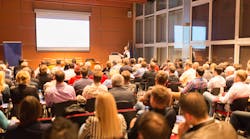IMS 2021 Delivers A Deep and Varied Live Technical Program
Check out our full coverage of IMS 2021.
What you'll learn:
- The live-event IMS 2021 will carry a full slate of technical sessions
- Monday features plenary keynote addresses and invited lectures
- Tuesday and Wednesday bring the technical-session meat
The coin that is the International Microwave Symposium, the live portion of which takes place next week in Atlanta, has the same two sides as any other coin. On one is the exhibition, where one can see, touch, and learn about the multitude of new products and services that will make their debuts at the event. This year's IMS show floor will feature over 300 exhibitors showcasing their offerings. That's always a prime attraction at any industry event, of course, and perhaps the most stimulating from a sensory perspective. A busy exhibition floor can be an exciting experience, with new and interesting things galore on which to get up to speed.
On the other side of the IMS coin is its technical program, which promises to be a memorable one in this year of rebound from the pandemic that drove last year's IMS to a total virtual format. Technical conferences may not be as fun as walking an exhibition floor, where one can see and greet industry colleagues and renew relationships. But for the technically curious minds of RF/microwave engineers, it's where you'll find the meat that attendees anticipate: new ideas and concepts that could spark subsequent waves of innovation in a field that thrives on invention.
Monday, June 7
The first day of the live IMS 2021 technical conference opens with a pair of plenary talks. Suresh Venkatarayalu, Chief Technology Officer of Honeywell, will welcome guests to the IMS 2021 with a special keynote talk. That same day, Dr. Ahmad Bahai, Chief Technology Officer and Senior Vice-President of Texas Instruments, will introduce the 2021 IEEE Radio Frequency Integrated Circuit Symposium (RFIC 2021), co-located with the IMS 2021 technical conference in the nearby Omni Hotel.
Monday will also feature a pair of invited lectures, the first of which will be delivered by Prof. Tim Brothers of the Georgia Institute of Technology. His talk, titled "Software Defined Radio Hardware and Software," comprises an overview of software-defined radio (SDR). In addition to a discussion of basic hardware, software, and firmware building blocks, Prof. Brothers will provide a hardware demonstration of a commercial SDR. He'll conclude with a discussion of enabling technologies behind the next generation of SDR systems.
A second invited lecture by Jeff Hesler, CTO of Virginia Diodes, will cover Terahertz technology and its progression from a scientific endeavor to a commercial one. The potential for non-scientific applications of THz has been understood for many years, but technological limits slowed the advance of these applications. Hesler's talk will cover recent developments in transistor technology that are now enabling rapid progress in a variety of applications, ranging from basic test & measurement, ultra-wideband communications, and the use of THz radiometers in space for next-generation commercial weather forecasting.
Tuesday, June 8
Tuesday marks the kickoff for the slate of technical sessions. Most of the sessions are chaired, and talks delivered, by high-flying academics from the world's most prestigious technical institutions. Some highlights include the following:
- "Novel Electromagnetic Structures and MetaSurfaces" comprises three presentations on topics such as metamaterial-based wireless power transfer in smart-home applications; a 4D-printed, tunable, multi-layer, frequency-selective surface for mm-Wave IoT, RFID, WSN, 5G, and smart-city applications; and a study of nanowire-based integrated via technology for CMOS applications at mmWave frequencies.
- "Advances on Ultra-Low-Power Circuits and Systems" offers presentations on an instinctual, interference-adaptive low-power receiver design; a 5.8-GHz, low-power, tunnel-diode-based two-way repeater for use in RFIDs and wireless sensor networks; and a multi-Gb/s data-communication link for machine-to-machine (M2M) interaction.
- "Advanced Waveguide Designs" will describe such technical innovations as a flexible, non-radiative dielectric PCB-to-NRD coupler with 1-dB loss in mmWave array applications; a high-order accurate, integral, and equation-based mode solver for layered nanophotonic waveguides; and a distributed, mixer-based leaky-wave antenna for simultaneous transmit and receive.
Wednesday, June 9
The technical program closes on Wednesday, but not before attendees can avail themselves of sessions like:
- "N-Path Receivers and Filters" covers innovative work in areas such as a tunable, multi-mode, quadrature-balanced N-path diplexer with nonlinear cross-modulation distortion correction; a 20-to-40-GHz, high dynamic-range HBT N-path receiver; and a 6-to-31 GHz tunable, reflection-mode N-path filter.
- "Wideband Front-End Building Blocks" features discussions of wideband SPDT and SP4T RF switches using phase-change material in a SiGe BiCMOS process; a 27-to-46-GHz low-noise amplifier with dual-resonant input matching and a transformer-based, broadband output network; and a W-band Wilkinson power divider with 1-dB insertion loss that uses silicon-based integrated passive devices.
- "Advanced Manufacturing and Flexible Electronics for RF/mmWave Circuits and Packaging" delves into back-end advances in such areas as batch-fabricated, substrate-embedded Ka-band circulators using screen-printed Strontium Hexaferrite/PDMS composites; in-package, additively-manufactured sensors for bend prediction and calibration of flexible phased arrays and hybrid electronics; and additive manufacturing of a wideband-capable W-band packaging strategy.
Again, these are just a few highlights of a much broader and deeper overall technical program. IMS 2021, in its first live outing of what we all hope is the post-COVID era (at least here in the United States), will be brimming over with fascinating and stimulating presentations. See you in Atlanta!

